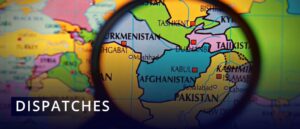Many assumed Islamic State Khorasan Province (ISKP or IS-K) was finished after its battlefield defeats, and their analysis fell short as IS-K carried out the deadliest bombing at Abbey Gate. This was followed by a suicide bombing in Bajaur, the Iran Kerman bombing, and the deadliest one in Moscow Crocus City Hall, killing 130 people. The group has re-emerged under the leadership of Shahab Al Muhajir, with transnational objectives and a renewed strategy: not to hold land, but to win minds.
This signals that the group’s true power was never in its fighters. ISKP has made clear that even if the group were to collapse, it would survive as an idea. The group has expanded its propaganda through Al Azaim media, targeting Central Asian youth.
In almost every transnational attack or foiled attack, the suspects arrested or killed are from the Central Asian Republics. From Iran to Moscow, Germany to Türkiye, all the suspected attackers were Central Asian. Under the leadership of Shahab al-Muhajir, Islamic State Khorasan (IS-K) has shifted toward highly localized recruitment strategies, leveraging native languages, regional scripts, and culturally resonant narratives to radicalize and mobilize youth across Central Asia.
Previous leaders from Hafiz Khan Saeed to Mawlawi Aslam Farooqi were engaged in holding territory and fighting within Afghanistan. In 2020, when Shahab Al Muhajir (Sanaullah Ghaffari) became the emir of IS-K, the group had suffered significant losses at the hands of US-led coalition forces, Afghan Taliban, and Pakistan counter terrorism campaigns. I
SKP sought to restore its scattered forces, increase recruitment, and propaganda activities under the direction of Shahab al-Muhajir. Al-Muhajir highlighted concealment and stealth as crucial strategies in ISKP’s current “phase of guerrilla warfare, encouraging hit-and-run tactics rather than holding territory. The term “Strategic Diversity,” coined by Amira Jadoon, refers to Al-Muhajir’s emphasis on internationalizing the group’s operations and objectives while broadening its group’s personnel composition.
In 2021, ISKP relaunched Central Asian propaganda activities, gaining significant attention regarding the group’s transnational intentions. ISKP propaganda through its Al Azaim foundation published extensively, targeting Central Asians. ISKP in its flagship magazine “Voice of Khorasan” issue 10th, released in August 2022, glorified the important role that Uzbeks and Tajiks played in the formation and succession of ISKP.
The Al-Azaim Foundation’s affiliated outlets began translating ISKP publications in Pashto and Farsi into Tajik and Uzbek, and the organization released original books in Tajik and Uzbek on religious and political subjects. ISKP employs highly localized narratives, such as launching a Tajik version of the Voice of Khorasan radio channel called Sadoi Khuroson. Between September 2021 and April 26, 2022, Voice of Khurasan Tajik, along with other regional Voice of Khurasan Radio channels in Pashto, Dari, and Uzbek, released around 150 audio recordings.
Many of them criticize the Taliban, pronouncing them excommunicated and urging attacks against them and their “democracy,” but the majority are succinct talks about jihad, aqidah (creed), and manhaj (methodology). Xuroson Ovozi Radio in Uzbek features hijrah stories and personal accounts of militants migrating from Central Asia to Afghanistan.
Additionally, the use of Cyrillic (Tajik) and Latin (Uzbek) scripts in these propaganda indicates that the messages are intended for Uzbek and Tajik citizens rather than the Tajik/Uzbek-speaking communities in Afghanistan who use Arabic scripts. ISKP promotes individual life stories and conversion journeys to draw sympathizers. For instance, shares biographies of defected IMU (Islamic Movement of Uzbekistan) members and interviews with defected members.
The Central Asian speakers express religious and socio-political grievances, including marginalization and disillusionment with their governments. ISKP consistently vilifies governments of Tajikistan and Uzbekistan, accusing them of secularism, suppressing Islam, taghuti (tyrannical), and accusing them of serving foreign interests (Russia, China, and the United States).
Furthermore, ISKP’s Central Asian channels frequently broadcast sermons by Sheikh Mustafa Darwishzadeh, Sheikh Obaidullah Mutawakkil, Ustad Abdul Zahir Da’i, and Sheikh Omar Salahuddin, among others, to legitimize their ideology.
The propaganda is not limited to men. A recently disbanded ISKP cell in Namangan was run by a 19-year-old woman who became radicalized while studying religion in Turkey, according to information recently released by Uzbekistan’s State Security Service (SSS). This highlights the evolving nature of terrorist propaganda and recruitment strategies. This rare case underscores the adaptability of terrorist groups like ISKP in leveraging diverse recruitment channels and challenging traditional roles.
ISKP produces extensive propaganda in Persian, Arabic, Urdu, Hindi, Malayalam, English, Uzbek, Tajik, Pashto, Russian, and Dari. The propaganda is so well tailored that in almost all ISKP’s external operations, the attackers turn out to be Central Asian, usually Tajiks and Uzbeks. ISKP has demonstrated skill in attracting Central Asian radicals and inspiring them to take action against its alleged adversaries, both domestically in Afghanistan and internationally.
For instance, the main suspect behind the Kerman bombing was a Tajik named Abdollah Tajiki. All the attackers in the Moscow Crocus City Hall attack were Tajiks. The attackers behind the Istanbul Santa Maria church shooting were from Tajikistan and Russian-Central Asian background. In July 2023, an ISIS-K cell made up of Tajik, Turkmen, and Kyrgyz nationals was busted in Germany and the Netherlands.
In conclusion, the group went underground with a strategy and now resurfaced with renewed operational planning. ISKP has successfully rebranded itself as a transnational threat by localizing the strategies of recruitment and creating propaganda appealing to the Central Asian audience.
Shahab al-Muhajir has progressed from the past strategy of holding territory to winning minds by ideological appeal using a highly localized propaganda narrative. Al Azaim Media Foundation is generating extensive propaganda in this regard. ISKP is the only group generating propaganda in many languages targeting diverse ethnicities. The frequent involvement of Central Asians in the ISKP’s external operation indicates the influence of propaganda in attracting Central Asian youth regardless of gender.
Disclaimer: The views expressed in the article are of the author and do not necessarily represent the institute’s policy.
Authored by: Muhammad Mudassir is a student at Quaid-I-Azam University, Islamabad.
Read More: Examining the Feasibility of an East-West Economic Corridor for South and Central Asia

